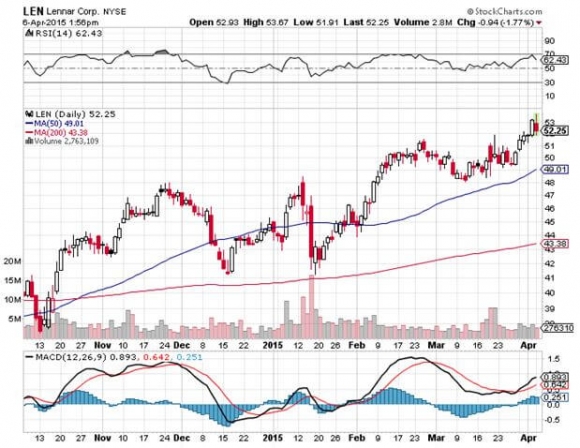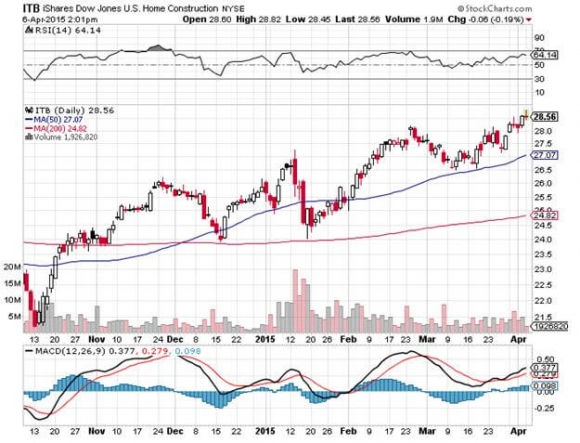As a potentially profitable opportunity presents itself, John will send you an alert with specific trade information as to what should be bought, when to buy it, and at what price. This is your chance to ?look over? John Thomas? shoulder as he gives you unparalleled insight on major world financial trends BEFORE they happen.
Follow Up to Trade Alert - (LEN) ? BUY-update
Buy the Lennar Homes (LEN) May, 2015 $45-$49 deep in-the-money vertical call spread at $3.45 or best
4-6-2015
expiration date: May 15, 2015
Portfolio weighting: 10%
Number of Contracts = 29 contracts
I am going to use this $1.60, or 3% drop in the shares of Lennar Homes (LEN) today to dip my toe into the booming housing sector.
You can buy this vertical bull call spread anywhere within a $4.35-$4.65 range and have a reasonable expectation of making money on this trade by the May 15 expiration.
If you can't do spreads, buy the stock outright of a medium term hold.
The markets should move back into a solidly ?RISK ON? environment from here. The Iran nuclear deal is a huge positive that has yet to be discounted by the markets.
On April 15, the US government swings from being a net taker to a net provider of funds to the financial system, as taxpayers begin to receive refund checks in large numbers, much of which ends up in the stock market.
Did I mention that April is the most positive month of the year for stocks?
The great thing about this spread is we have to decisively break to 50 day moving average at $49 in the next month to lose money, a rare event.
You would think that homebuilders would be the worst place in the world to invest right after the biggest bull market in bonds in history is ending, and interest rates are going to rise.
Not so.
In fact, homebuilders are the current number one pick of Bill Miller, the legendary stock picker at fund manager Legg Mason. He argues strongly that it will be the easiest place to make money in the market for the rest of the decade, with the stocks doubling or more from current levels.
I like the sound of this.
Bill argues that there is a 500,000-unit deficit in homebuilding industry capacity compared to market demand. It trades at a 25% discount to the S&P 500 earnings multiple of 17X. He expects profit growth to run at a 20% annual rate for the next 3-5 years.
And let?s face it. The data out of the real estate industry in February was nothing less that blockbuster. February new home sales were up a red hot 7.8%, and January was revised up to a smoking 4%. February pending home sales clocked 6.1%, and 12% year on year.
When you see an entire data range catch fire like this, it becomes highly convincing.
This rocketing demand is occurring in the face of shrinking supply. There are now only 1.8 million existing homes on the market in the United States, a 4.6 month supply, close to an historic low. Real estate agents are clamoring for new supply, but the builders are taking their own sweet time.
After a quiescent 2014, home prices in America have started to rise once again.
You would think that anyone going into the homebuilders just as interest rates are starting to increase has a hole in their head. But look at the correlation between rates and homebuilder share prices, and the opposite is true.
When prices began their meteoric rise last year, culminating in an eye popping 1.62% yield on ten year Treasury bonds (TLT) in January, homebuilder stocks looked liked they had Montezuma?s revenge.
Now that rates have backed off, and the Fed has been rattling its saber for more interest rate rises (goodbye ?patience?), the sector has been on fire.
The reason is that the Fed will raise rates only if they see inflation coming. This would be fantastic news for the entire real estate industry, the most reliable inflation hedge out there for the individual investor.
Having your inventory appreciate in value through no effort of your own is also about the best thing that can happen to any developer.
The key to understanding these stocks is that this is not your father?s real estate industry.
Absolutely no one competes for market share anymore. Companies are constructing only enough homes they are certain to sell at high margins. They're also getting cagier on land acquisition costs.
Hence they shortage.
Look no further than Lennar (LEN). At the top of the last housing cycle in 2005, they built 53,000 houses. In 2015, they will construct only 25,000, but will earn a far greater profit margin on them.
Those firms that reached for market share with leverage were wiped out by the great cleansing of the 2008 crash, or were taken over for pennies on the dollar.
Mind you, the industry still has major challenges. The entry-level buyer is missing in action, as millions of students buckle under crushing debt loads. Some 10% of all homeowners representing 5.4 million units are still underwater on their mortgages, blocking trade ups.
These factors alone explained the market?s and the homebuilder shares? lack of sizzle in 2014.
But longer term, the outlook is fantastic.
My ?Golden Age? scenario for the 2020?s make the homebuilders an absolute sweet spot to be in. A demographic shortfall will make workers scarce, lead to rising wages, and at long last bring a return of inflation. It is a perfect storm for rising home prices.
Could the market already be starting to discount the great things to come in the next decade?
In addition to (LEN), the usual suspects in this sector include Pulte Homes (PHM), KB Homes (KBH), the old Kaufman & Broad (who sold out right at the top), and DR Horton (DHI). You can also contemplate the Real Estate iShares ETF (IYR).
Lennar is based in Miami, Florida, and is a national builder of single-family homes, with major operations in Arizona, California, Colorado, Delaware, Florida, Georgia, Illinois, Maryland, Massachusetts, Minnesota, Nevada, New Jersey, New York, North Carolina, Pennsylvania, South Carolina, Texas, Virginia.
During the nineties, they particularly focused on converting decommissioned military basis into large, low end housing estates, such as at the Marine Corps Air Station at El Toro, March Air Force Base, Treasure Island, Mare Island, and Hunters Point, all in California.
At the peak of the last housing bubble in 2006, they were the second largest homebuilder in the United States, and were considered one of the best run companies in the country.
During the crash, Lennar suffered a near death experience, losing $2.4 billion in two years. New discipline, streamlined costs, and deleveraging have since restored the firm to profitability.
The best execution can be had by placing your bid for the entire spread in the middle market and waiting for the market to come to you. The difference between the bid and the offer on these deep in-the-money spread trades can be enormous.
Don?t execute the legs individually or you will end up losing much of your profit. Spread pricing can be very volatile on expiration months farther out.
If the price of this spread has moved more than 5% by the time you receive this Trade Alert, don?t chase it. Wait for the next one. There are plenty of fish in the sea.
Here are the specific trades you need to execute this position:
Buy 29 May, 2015 (LEN) $45 calls at?????$7.35
Sell short 29 May, 2015 (LEN) $49 calls at..??.$3.90
Net Cost:????????????..???.....$3.45
Potential Profit: $4.00 - $3.45 = $0.55
(29 X 100 X $0.55) = $1,595 or 1.60% profit for the notional $100,000 portfolio.







